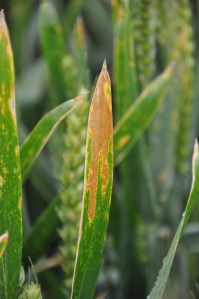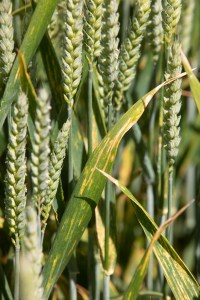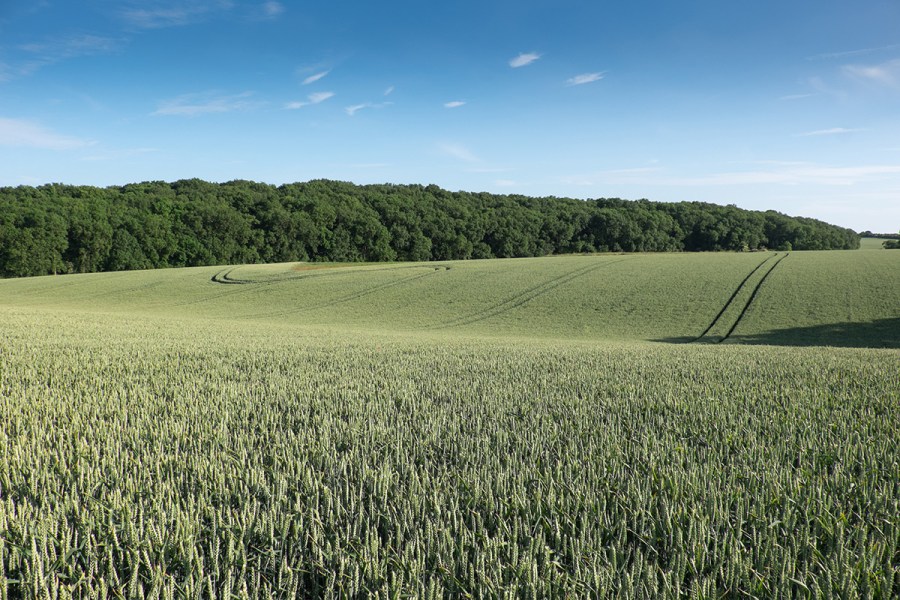Combining plant genetics, chemical controls and biologicals could be the key to maximising wheat performance and mitigating the risks posed by variable growing conditions. CPM speaks to Openfield to get up to speed with the latest options.
“Chemistry protects chemistry and chemistry protects genetics.”
By Melanie Jenkins
If anyone could accurately predict how each growing season would unfold, there’d be a lot of money in it for them, but the reality is no one has this power and it’s a case of taking each year as it comes. However, varietal selection and planning crop protection carefully can help mitigate the risks.

The importance of a robust fungicide programme can’t be underestimated, stresses Duncan Durno.
This year has been a case in point. Heavy and persistent rainfall throughout March and much of April caused delays to fertiliser and crop protection applications. As a consequence, T1 timings were a challenge this year.
According to Openfield’s arable technical manager, Duncan Durno, the difficult start provided a window of opportunity for disease to flourish in susceptible varieties. He says this season has highlighted the risk from septoria, which hasn’t threatened for the past couple of seasons. “We know septoria and yellow rust are yield robbing diseases, but this year will reinforce that septoria is the number one disease in terms of yield loss and difficulty to control. And whereas yellow rust can cause large yield losses, it’s often easier to control compared with septoria.”
It’s because of this ever-present disease threat and the vagaries of the British weather that makes variety choice so important, stresses Duncan. “When you’re deciding which varieties to put in the ground in the autumn, you’ve no idea what conditions are going to be like in the spring, which is why robustness and resilience against septoria and yellow rust is so vital.”
Choosing genetic resistance to disease isn’t just about mitigating damage in high-risk years but it’s also important to give flexibility and manage risk in lower disease years, says Duncan. “Variety choice encompasses maximising the gross output of the crop but also mitigating any risks so it reaches its yield potential. Growing wheat is always going to boil down to the economics.”
So where is a good starting pointwhen it comes to variety choice? Duncan feels that market selection should be the first port of call for any grower. “Selecting which Group to grow should be based on the proximity to buyers for the grain, yield potential of the farm and practicalities around management.
“But with the current Group 1 varieties there’s very limited choice for the coming season, with only four on AHDB’s Recommended List and two of those showing very little resistance to yellow rust,” warns Duncan. “Yes, they come with a premium, but they also come with a higher risk, more management requirements and increased growing costs.”
Duncan feels that both Crusoe and RGT Illustrious are the most resilient varieties in the group. “Both have excellent yellow rust resistance (9 and 8, respectively) and Crusoe is also very strong against septoria (6.2).
“Crusoe’s disease resistance hasn’t wavered since 2012 and it exhibits great grain quality. End users like it, making it the number one choice for growers and it gained an increased market share again last year.”
Group 2 varieties can also attract a premium and those on the RL demonstrate an improved yield over Group 1, says Duncan. “Group 2 varieties can obtain a premium but two thirds of the acreage don’t reach the specification for milling. However, the reason Group 2 varieties are proving so attractive is because of their disease resistance, and any premium is a bonus.”
Septoria resistance is one of the biggest influences for selecting Group 2 varieties. “KWS Extase and KWS Palladium have the best combination of strong disease resistance (7.8 and 7.4 against septoria, respectively) and yield (102% and 100%). Both varieties stand out for having lower levels of septoria than many varieties,” says Duncan.
“Extase is the number one variety, but it’s a forward growth habit doesn’t make it suitable for every situation. Being a less forward type, Palladium fits nicely alongside it, providing different genetics on farm that can help offset some risk and allow for earlier drilling.”
Looking at Group 3s, Duncan expresses caution. “This is potentially a difficult group. The market for Group 3s has gone back massively, largely due to the lack of end user demand and available premiums but also because of the yield lag compared with Group 4s, both soft and hard. Then there’s the weaker septoria resistance in this group. But if you can secure a premium that offsets the yields and the risks, then growing a Group 3 can work for you,” notes Duncan.

This year will likely reinforce that septoria is the number one disease in terms of yield loss and difficulty to control.
Although the area of Group 4 soft wheats being grown has reduced, varieties in this group have very good yellow rust resistance, says Duncan. “However, there’s uncertainty around septoria resistance in some of the varieties. Also, varieties in this group tend to be taller and higher biomass types, which increases the risk of lodging and reduces flexibility in terms of drilling date and soil type.
“However, two new varieties may go some way towards addressing these issues,” says Duncan. “Of these, LG Redwald is the highest yielding variety on the RL and has strong yellow rust resistance (7). It also improves the level of septoria resistance available in the group, at 6.7. But it’s tall and is a high biomass type that will require drilling later, from early October onwards.”
KWS Zealum is the second new addition to the RL this year. “It’s slightly lower yielding compared with Redwald, but it brings robustness and flexibility to the group and is suitable to early drilling, where it performs best.”
When it comes to disease resistance, Duncan describes Zealum’s septoria rating as ‘okay’ at 5.8 on the RL. “But the variety has excellent yellow rust resistance (9), orange wheat blossom midge resistance and has very stiff straw. So from a risk management angle, it ticks a lot of boxes.”
“The variety with the biggest market share is LG Skyscraper, which performs consistently on farm year-on-year in almost all situations, but it does have a low septoria rating (4.9). However, it’s untreated yield (86%) and farm performance has always been better than its septoria score suggests it should be.

The difficult spring has provided a window of opportunity for disease, such as yellow rust, to flourish in susceptible varieties.
“Moving on to the Group 4 hard varieties, these offer growers not just high yields and good disease resistance but even more in terms of growth habit, allowing growers greater flexibility around management decisions, drilling programmes and field choices,” he says. “The two newer varieties in this group, KWS Dawsum and Champion, which produce very high yields, are cases in point.”
Dawsum brings strong disease resistance (9 for yellow rust and 6.4 for septoria) and short, stiff straw, as well as a slower growth habit, making it very suitable for the early and main drilling slot, explains Duncan. “Whereas Champion is the opposite. It’s a tall and very forward growing variety with a high biomass, ideal for the end of the main and into the later drilling window.
“Champion also brings very good septoria resistance (8.1) which provides risk management around disease and fungicide programmes.”
For those wishing to drill later as part of a blackgrass control strategy, Duncan recommends KWS Cranium. “This is a forward, high biomass type that is very competitive against blackgrass. Often, we see these types having weaker straw, but Cranium is one of the stiffest varieties on the RL making it perfect to drill on heavier fertile sites where blackgrass is often a problem,” he says. It also has a good yield (102%), yellow rust resistance of 9 and a decent septoria score (5.9).
But no matter how carefully growers select varieties based on the robustness of their disease package, in years like this one the importance of a fungicide programme can’t be underestimated, stresses Duncan. “Sometimes, in lower risk years, there’s wriggle room to lower rates or adjust chemical inputs, but it’s important not to cut too far because fungicides are helping to protect genetics in years like the one we’re currently experiencing. Working genetics and chemistry together has to be part of the overall package and management strategy.”
Working the canopy

Jonathan Helliwell believes it’s critical to maintain a green canopy for as long as practically possible after flowering, to intercept sunlight and enhance grain fill.
To maximise yield and get the most from fungicide programmes, BASF has worked with ADAS over a number of years to look at healthy area duration (HAD) and the value of a green canopy in wheat, says BASF’s Jonathan Helliwell.
“It’s critical to maintain a green canopy for as long as practically possible after flowering, as this will intercept sunlight and enhance grain fill and yield,” he says.
“Work conducted by ADAS and YEN has shown that UK wheat crops aren’t reaching their potential because they tend to be source limited – meaning limitations to the sunlight they can absorb – so the aim of BASF’s work has been to reduce this limitation and maximise the light crops intercept.
“Wheat can gain 0.2t/ha per day in grain fill during the post-flowering period, so long as the crop is kept green. The longer we can keep it green the bigger the difference.”
HAD is a combination of green leaf area recordings throughout the season, an effective indication of size and duration of healthy green leaf, with each unit of HAD worth approximately 0.05t/ha yield increase, says Jonathan.
“Over a number of years, we’ve identified that the link between HAD and yield is linear, and UK yields aren’t currently reaching the plateau of this relationship. So this poses the question of how can we increase this yield by combining stronger genetics, the best fungicides and dose rate.”
Looking at varietal resistance, Jonathan explains that a higher septoria resistance doesn’t stop the disease infecting the crop, it just “pushes the epidemic through time and delays the development of the disease.” So stronger varieties buy more time and flexibility with fungicide timings.
“Research with NIAB trials in 2021 – where cool conditions delayed the emergence of leaves, demonstrated that the same variety can have a 10-14 day gap between the first and last flag leaf emerging in the crop,” he says. “As a grower, it’s really difficult to effectively time a single T2 spray to hit flag leaf fully emerged in the entire crop, meaning some of the leaves require more protectant and some more curative control.”
But work with ADAS highlighted that using Revysol (mefentrifluconazole), either 10 days before or 10 days after the ideal spray timing, provided better protection than using prothioconazole at its ideal application time, explains Jonathan. “So growers can have flexibility from varietal genetics and from their chemistry selection.”
Other research looking at controlling septoria and the value this adds to HAD, addressed the impact of T2 applications on different varieties. “We’re asking T2 chemistry to do a different job to T1s, it’s about controlling the disease already in the crop as well as providing protection for six to eight weeks after application.
“Our work looked at the longevity of the canopy in 2021, where we applied five different doses of Revystar XE (fluxapyroxad+ mefentrifluconazole) across a number of varieties with various septoria scores,” says Jonathan. “Dose rates started at zero and went up incrementally by 25%. It was interesting looking at the yield response, which was almost independent of the resistance rating. Regardless of genetic resistance, there was an increase in yield, even on the strongest varieties, by increasing Revystar dose.”
Jonathan points out that protecting genetics and chemistry is also down to using effective partners in the fungicide tank-mix. “And by partnering two effective modes of action, such as in Revystar, each is also helping to prolong HAD.
“The most successful disease control programme will use an integrated approach of good varietal choice along with the strongest and most flexible chemistry, which will help maintain a green canopy to achieve the best yield potential,” he says. “Chemistry protects chemistry and chemistry protects genetics. So avoid relying too heavily on one component and keep the financial implications in mind. Reducing risk and justifies the spend.”
Seed considerations
Beyond genetic and chemical control lies biologicals and biostimulants, which have flooded the market in recent years, says Duncan. “Agrii has looked closely at products to determine which have the most to offer on farm, and Nuello iN – formerly Tiros – stood out as a biological seed treatment which introduces endophytes into the plant to utilise nitrogen from the air.
“In springs like 2021 and 2022, where there was drought and poor N uptake because of the dry soils, having endophytes in the plants supplying N keeps things ticking over in these conditions, allowing plants to utilise N rather than stagnating.”
The endophyte bacteria in Nuello iN (Pseudomonas siliginis and Curtobacterium salicaceae) are proven to fix atmospheric N, explains Jon Ronksley of Syngenta. “This is a seed treatment so by February the benefits are already coming through.
“Last year we conducted some nitrogen response trials work that demonstrated the endophytes are producing up to the equivalent of 30kgN/ha,” he says. “This has been backed up by Kansas University, which carried out trial work looking at N fixation. Results showed the delivery of 23kgN/ha from the Pseudomonas strain alone.”
According to Jon, the endophytes are also adding rooting and improved greening. “The consequences of which are healthier crops and increased chlorophyll levels. The biggest benefits can be seen in N-limited soils, like on lighter land or in second cereal situations.”
But the key advantage of using the biological seed treatment is as an insurance policy in case weather conditions become tricky, says Jon. “Farming is all about risk mitigation and this can help growers with that. It’s of great benefit in a full fertiliser programme but if you are planning to cut back on application, trials have shown it can help.”
The industry is in a position where more treatments are diminishing and being lost than are coming along, says Duncan. “Looking at different options and taking a rounded approach going forward will help you manage risk.”
Better buying, better selling

To remain at the forefront of arable farming and to maximise the value from every hectare of crop grown requires a keen understanding of the grain market, the seed to supply it, and the fertiliser to feed the crop.
Through this series of articles, CPM is working with Openfield to provide a market insight and help farmers to focus on these major business decisions to ensure better buying of inputs, and better selling of the produce.
Openfield is Britain’s only national farming grain-marketing and arable inputs co-operative, owned by over 4000 arable. Openfield’s team works with a total of 6000 farmers to supply some of the biggest and best-known names in the British food and drink manufacturing industry.
But there’s more than just grain to Openfield, supplying seed and fertiliser, providing grain storage and offering expert advice on grain marketing and risk management. This delivers innovative supply chain solutions to its farmers and clients.
This article was taken from the latest issue of CPM. For more articles like this, subscribe here.
Sign up for Crop Production Magazine’s FREE e-newsletter here.




